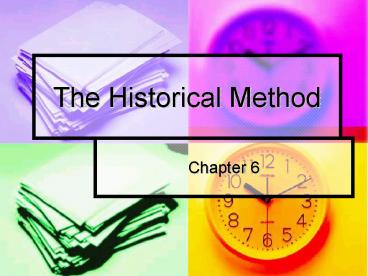The Historical Method - PowerPoint PPT Presentation
1 / 16
Title:
The Historical Method
Description:
Historical research: the systematic collection and objective ... Gay, L.R. (1992) Education Research. Chapter 6. New York: McMillan Publishing. Leedy & Ormond. ... – PowerPoint PPT presentation
Number of Views:79
Avg rating:3.0/5.0
Title: The Historical Method
1
The Historical Method
- Chapter 6
2
Definition and Purpose
- Historical research the systematic collection
and objective evaluation of data related to past
occurrences in order to test hypothesis
3
- Steps to historical research
- Definition of a problem
- Formulation of hypotheses
- Systematic collection of data
- Objective evaluation
- Confirmation or disconfirmation of hypotheses
4
Interpretation
- We need to define a question or problem before
doing research and data collection in order to be
systematic, objective and include all possible
sources of information.
5
Definition of a Problem
- The purpose of a historical research to explain
or predict - Limited to whatever data are already available
- Better to study in depth a well defined problem
with specific hypothesis, than to investigate a
too-broadly stated problem, or one which
insufficient data is available
6
Data Collection
- The review of related literature and study
procedures are part of the same process - Literature all sorts of written communication
7
- Written communication can be legal documents,
records, minutes of meetings, letters - In education might involve interviews
8
- Primary sources firsthand information
- Original documents
- Reports by participants
- Direct observers
- Secondary sources second hand information
- Reference books
- Reports by relatives of participants or observers
9
Data Analysis External and Criticism
- All sources of historical data as subjected to
analysis to - determine its authenticity (external)
- accuracy (internal)
10
When determining the accuracy must consider four
factors
- Knowledge and competence of the author
- Time delay between the occurrence and recording
of events - Biases of author
- Consistency of data
11
Data Synthesis
- Historical data should be organized and
synthesized (put all the pieces together) and
conclusions and generalizations drawn
12
- Summarization of historical research data
involves logical analysis rather than statistical
analysis, the researcher must take care to be as
objective as possible - ensure that all sources are considered not only
those that support the hypothesis
13
Confirmation or Disconfirmation of Hypothesis
- when evaluating your analysis and sources, you
may discover that you may not confirm your
hypothesis, but create new possible questions for
further study
14
Guidelines of Writing the Historical Research
Report
- State your own argument or question early and
your interpretations of your research results - Provide examples to support your findings to
provide validity for your interpretation
15
- Provide an objective overview of the topic that
includes other interpretations that may differ
from your own but also show why your
interpretation, using data is new or unique. - Point out any possible unsubstantiated sections
of your interpretation in order to present
yourself as an objective and credible researcher
and suggest that it merits further investigation.
16
SOURCES
- Gay, L.R. (1992) Education Research. Chapter 6.
New York McMillan Publishing. - Leedy Ormond. (2001) Practical Research
Planning and Design. Chapter 8. 8th Edition.































